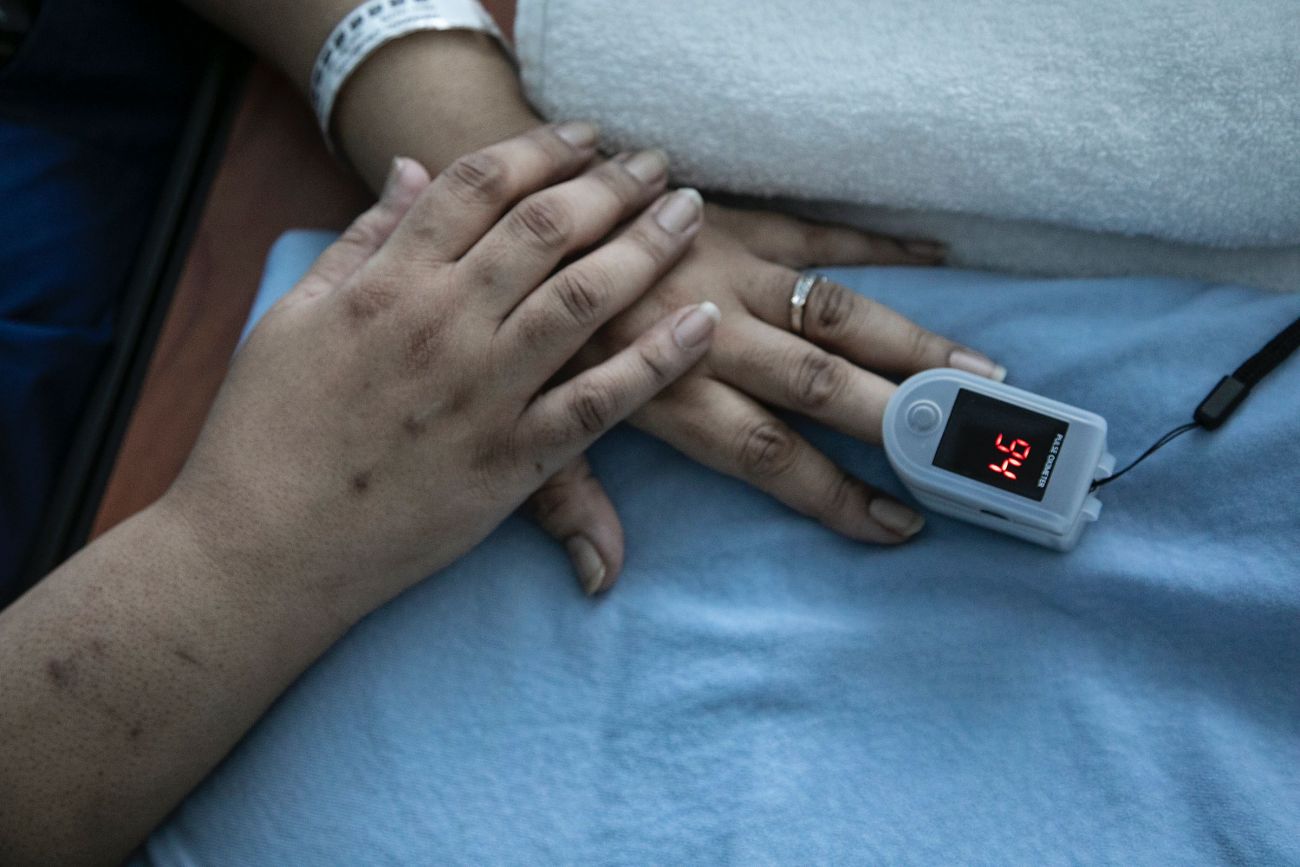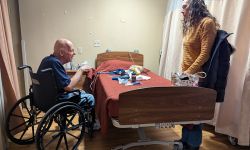In Michigan, 23K are ‘recovered’ from COVID. Many still feel like hell.

As a data point on the state’s coronavirus dashboard, Nancy Blodgett has moved to “recovered.”
And yes, she’s home after getting whomped full-force by COVID-19.
- Gov. Whitmer extends Michigan coronavirus stay-at-home order to May 28
- Whitmer reopens Michigan from coronavirus in phases: What that means to you
- The latest: Michigan coronavirus map, curve, chart, updated COVID-19 news
- Related: Michigan’s definition of coronavirus ‘recovery’ looser than other states
But recovered? Not even close.
“Heavens no. ‘Recovered’ is when you can go back to work [and] when you can walk to the mailbox and not struggle to breathe” said the woman who lives in Portage in southwest Michigan.
“‘Recovered,’” Blodgett said last week, “is when you get your life back. It will take some time.”
As Michigan enters its third month of COVID-19, those hit first and worst by the virus that has infected more than 45,000 state residents are being weaned off vents, leaving hospitals and heading home only to realize that the virus may no longer infect them, but it’s left their bodies weakened and wrecked.
Michigan health officials list nearly 23,000 patients as “recovered” from the virus, but it’s a loose definition and includes all patients “who are 30 days out from their onset of illness.” To be sure, some patients are mostly recuperated after leaving hospitals, but for countless others, the road to true recovery is daunting and uncharted.
As of Saturday, more than 1,500 people remained hospitalized with COVID-19, including 539 on ventilators, according to state data.
“The doctors keep telling me they can’t tell me what’s going to happen,” said Jeff Curtis, 66, of Osseo who spent three days on a ventilator at Hillsdale Hospital. Nearly a month later, he said pain through his arms and legs is overwhelming and the exhaustion, ever-present.
“They can’t tell me what’s normal and what’s not. It’s too new.”
Doctors do know, however, that COVID-19 can set off a storm of immune responses that can kill cells — a “storm of cytotoxins” — that can hurt or even shut down the heart, liver and kidneys, said Dr. Sheryl Wissman, chief medical officer for Ascension Providence Rochester, which opened a 12-bed recovery unit April 22.

At Mary Free Bed Rehabilitation Hospital in Grand Rapids, Dr. Ralph Wang said some patients have been so hypoxic, or deprived of oxygen, that their brains now struggle to perform simple tasks — “almost like a mild brain injury.”
Some patients, Wang said, must “learn to walk and talk and go to the bathroom” again.
Even if a patient isn’t hypoxic, it can take a week or more to readjust from “hospital-associated delirium,” said Dr. Samuel Allen, a critical care pulmonologist at Beaumont Health.
“You’re in a bed looking at the ceiling for 21 days. The light in the hallway is on. Someone is in every four hours to check on you so you don’t get that [deep] sleep, and you lose sense of day and night,” he said.
In worst-case scenarios, there is severe organ failure, too.
Researchers in Wuhan, China, in January and February found that 19 percent of 416 patients, or nearly 1 in 5, had signs of heart damage, according to one study. Another study found that 36.4 percent of 214 patients in Wuhan, or about 1 in 3, showed signs of neurologic damage. Both were published last month in journals by the American Medical Association.
Additionally, New York doctors have reported kidney damage so serious patients require dialysis, and autopsies on 26 Chinese patients of COVID-19 found that nine had signs of kidney damage — “direct evidence of the invasion of [the virus] into kidney tissue.”
“As people started to recover, we realized that this was different from other ICU or intensive illnesses,” said Ascension’s Wissman.“This is whole-body system shutdown.”
Even patients without permanent organ damage may struggle for weeks or months, their muscles so weakened from non-use.
Stories from the front
Bridge Magazine, the Detroit Free Press and Michigan Radio are teaming up to report on Michigan hospitals during the coronavirus pandemic. We will be sharing accounts of the challenges doctors, nurses and other hospital personnel face as they work to treat patients and save lives.
If you work in a Michigan hospital, we would love to hear from you. You can contact Robin Erb rerb@bridgemi.comat Bridge, Kristen Jordan Shamus kshamus@freepress.com at the Free Press and Kate Wells katwells@umich.edu at Michigan Radio.
“Usually people would be in the intensive care unit for a week or 10 days, and now we have people that have been here, you know, 20, 30 days,” Wissman said.
‘I don’t have the breath’
It was a joyful moment April 12 when Curtis was wheeled by staff out of Hillsdale Hospital — moments caught by a video on Facebook.
He wanted to be home. He wanted to see family. He wanted to return to his 30- by 50-foot pole barn and tinker with his Honda VTX 1300 motor trike and camper.
But the bright sun and blue sky Thursday seemed a cruel tease.
Curtis, 66, is still on a walker and an oxygen tank nearly a month after he left the hospital. He hasn’t made it from his house to his barn just 300 feet away.
“I have a day that seems like I’ll be OK, and then the next I can’t get out of bed,” he said.
It takes more than an hour to shower: “I don’t have the breath,” he said.
Now, formerly contained emotions spill over often, said the former owner of an asphalt company.
“I go out on my porch every day and cry,” he said. “That’s not me.”
Eric Goedge spent more than a week at Beaumont Royal Oak hospital, fighting COVID-19.
The Berkley man was rushed by an ambulance to Beaumont on March 28 — so weak he’d been unable to leave his own bed for three days. He never was on a ventilator, and though miserable, he remained alert his entire stay, Goedge said.
Surely, then, he’d bounce back, he thought.
He was stunned that when he arrived back home April 5, he could no longer climb the stairs of his house without pulling himself up by his arms.
The slow comeback is maddening, said Geodge, who coordinates telecommunications field technicians. Just within the past week he’s “starting to feel pretty close to normal.”
The Rehabilitation Institute of Michigan, part of the Detroit Medical Center, has treated more than a dozen patients transferred from other hospitals for post-COVID recovery.
Additionally, it is opening an outpatient program for those who go home and realize "it still takes everything out [them] to go from my bedroom to my bathroom," said Patty Jobbitt, the institute’s CEO.
In both programs, however, therapy clients must be past the point of contagiousness.
Henry Ford Health System designated 17 of its 40-bed therapy unit at Henry Ford Macomb Hospital specifically for COVID-19 patients, serving 28 patients from the system's Macomb and Detroit hospitals in April. (Other patients were still so weak they were released to nursing homes.)
The Detroit hospital, meanwhile, extended therapy twice daily, rather than once, and into weekends to its patients, preparing them to return home, according to David Olejarz, Henry Ford spokesperson.
‘It was frightening. I just cried.”
For her part, Blodgett, 55, drove to the Bronson Hospital emergency room in Kalamazoo on March 26 with what she thought was the flu. Tested positive for COVID-19, things got worse and fast.
Finally on April 17, she left Bronson after 21 days fighting coronavirus, including nine days on a ventilator. She began therapy at Mary Free Bed in Grand Rapids, which a day earlier had opened a new 16-bed ReCOVery Unit — a separated rehabilitation unit for COVID-19 patients.
The longtime logistics supervisor at Humphrey Products, which ironically manufacturers parts for ventilators, had been sedated while on a ventilator.
But while that may ensure the comfort and safety of a patient in a life-threatening crisis, it means unused muscles begin to atrophy — legs, arms, torso, even the chest muscles that help with breathing, said Terry Milnamow, an occupational therapist who worked with Blodgett.
“It’s severe deconditioning and a lot of stress on the body,” he said.
Things like walking across the room, climbing stairs or even standing up from the toilet are impossible without help, he said.
“My legs were Jell-O. I hadn't walked in over a month,” Blodgett said.
Blodgett also found that the ventilator left damage — wrecking her voice and, worse, making it dangerous to swallow. Staff taught her to use special thickeners for her water and cranberry juice, making the liquids easier to manage. She decided to skip the coffee for a while.
“I can’t do that,” she said, laughing about it now. “It's awful. Thick coffee is like something at the bottom of the pot.”
Blodgett also was surprised at how COVID-19 had ground down her emotional and mental resolve in the hospital.
For weeks, her only human contact in a strange hospital room had been strangers’ eyes above masks and behind face shields. She had been groggy and defiant at the hospital, yanking out a feeding tube several times, something she’d never consider under normal circumstances.”
“I’m not like that. But for days, there was this fear of not seeing anyone I knew. It was frightening. I just cried,” she said.

Lingering respiratory issues for COVID-19 patients mean the very act of breathing can be difficult as they struggle against a mental fog and reteach bodies basic tasks, therapist Milnamow said.
“Your lungs aren’t as effective as they were,” he said. “A lot of times, [patients aren’t] limited as much by their muscle strength but by their breathing.”
For many, showering now requires extraordinary safety planning — setting out shower supplies before, arranging clothes so they can be put on more easily afterward, strategizing the placement of a cane or walker and a seat for frequent resting, said occupational therapist Chris Boer, who also worked with Blodgett.
He said his patients often tell him “it shouldn’t be this hard.”
Blodgett agreed: Part of recovery at the start is the mental game — pushing forward while also allowing herself to sit and breathe “and pace myself.”
“But every day, I’m stronger,” she said. “It may take some time, but I’ll get there.”
Detroit Free Press reporter Kristen Shamus contributed to this report.
See what new members are saying about why they donated to Bridge Michigan:
- “In order for this information to be accurate and unbiased it must be underwritten by its readers, not by special interests.” - Larry S.
- “Not many other media sources report on the topics Bridge does.” - Susan B.
- “Your journalism is outstanding and rare these days.” - Mark S.
If you want to ensure the future of nonpartisan, nonprofit Michigan journalism, please become a member today. You, too, will be asked why you donated and maybe we'll feature your quote next time!








